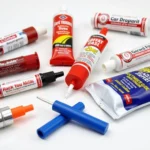The dreaded tire pressure monitoring system (TPMS) light. It can strike fear into the heart of any driver, especially if you’re not sure what it means or how to fix it. Don’t worry, this article will guide you through everything you need to know about that pesky tire light, from understanding why it’s on to simple repair techniques.
What Does the Tire Light Mean?
The tire light on your car dashboard, often depicted as an exclamation mark inside a horseshoe shape, indicates a problem with your tire pressure monitoring system. This system is designed to alert you when one or more of your tires are significantly underinflated, potentially leading to dangerous driving conditions and reduced fuel efficiency.
Common Causes of a Tire Light
There are several reasons why your tire light might be on:
- Underinflated Tire(s): The most common culprit is simply one or more tires lacking sufficient air pressure.
- Temperature Changes: Significant drops in temperature can cause the air inside your tires to contract, leading to lower pressure readings and triggering the TPMS light.
- Slow Leak: A small puncture in your tire, a faulty valve stem, or even a porous wheel can cause a slow leak, gradually reducing tire pressure over time.
- Sensor Malfunction: Occasionally, the TPMS sensor itself can malfunction or have a dead battery, sending an inaccurate signal.
- Recent Tire Service: If you’ve recently had your tires rotated, changed, or repaired, the TPMS system might need to be reset.
How to Repair Your Tire Light Issue
Before you panic, remember that most tire light issues can be resolved with a few simple steps:
1. Check Your Tire Pressure: Find the recommended tire pressure for your vehicle, usually listed on a sticker inside the driver’s side door jamb or in your owner’s manual. Use a reliable tire pressure gauge to check each tire, including the spare.
2. Inflate Tires to the Correct Pressure: If any tires are underinflated, add air until they reach the recommended PSI (pounds per square inch). Don’t overinflate!
3. Reset the TPMS: Refer to your owner’s manual for the specific procedure to reset your TPMS. This usually involves driving for a certain distance or performing a combination of button presses on your dashboard.
4. Inspect for Leaks: If your tire light comes back on shortly after inflating your tires, you may have a slow leak. You can check for leaks by spraying a soapy water solution on your tires and looking for bubbles.
When to Seek Professional Help
While many tire light issues can be addressed with basic DIY solutions, certain situations warrant a visit to a qualified mechanic:
- Persistent Leaks: If you’re unable to locate or fix a leak yourself, a professional can identify and repair the issue.
- TPMS Sensor Problems: Diagnosing and replacing faulty TPMS sensors often requires specialized tools and expertise.
- Unusual Tire Wear: Uneven tire wear patterns can be a sign of alignment issues or other problems that should be addressed by a professional.
Importance of Maintaining Proper Tire Pressure
Maintaining correct tire pressure is crucial for several reasons:
- Safety: Properly inflated tires ensure optimal handling, braking, and overall vehicle control, reducing the risk of accidents.
- Fuel Efficiency: Underinflated tires create more rolling resistance, forcing your engine to work harder and consuming more fuel.
- Tire Longevity: Driving on underinflated tires can lead to premature and uneven wear, shortening the lifespan of your tires.
FAQs About Tire Light Issues
Q: Can I drive with the tire light on?
A: It’s not recommended. Driving with underinflated tires can be dangerous and damage your tires. Address the issue promptly.
Q: How long does a TPMS sensor battery last?
A: TPMS sensor batteries typically last 5-10 years depending on driving conditions and sensor quality.
Q: Can I replace a TPMS sensor myself?
A: While possible, replacing TPMS sensors requires special tools and knowledge. It’s often best left to professionals.
Conclusion
Understanding why your tire light is on and knowing how to address the issue is essential for every driver. By following the steps outlined in this guide, you can confidently tackle most tire light problems and ensure a safe and enjoyable driving experience. If you’re ever unsure or encounter a persistent issue, don’t hesitate to seek help from a qualified mechanic. Remember, maintaining proper tire pressure is a simple yet crucial aspect of car care that directly impacts your safety and the longevity of your vehicle.
For more information on car repairs and maintenance, check out our guides on self maintenance car repair lights and how to repair cracked car light. You can also find helpful tips on repair light scratches on car and car light lens repair. If you have issues with your car’s electrical system, you might find our article on can you repair car cigarette lighter insightful.
If you are experiencing persistent car trouble or need expert advice, don’t hesitate to contact us via WhatsApp at +1(641)206-8880 or email us at [email protected]. Our dedicated customer support team is available 24/7 to assist you with all your car repair needs.

